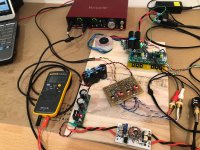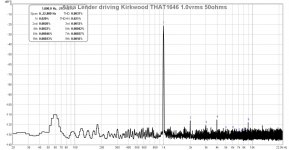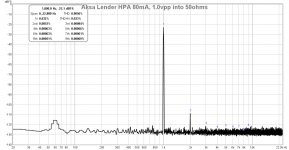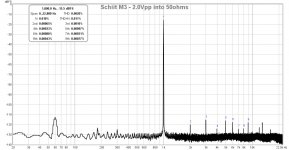Another not so great discovery tonight. I tried to fit the Lorlin CK-1051 selector switch on the PCB. The A, B, and C lugs in the center are not lining up with the holes in the PCB. Anyone else running into this?
Yup, same here.
Just checked the selector switch fitment and the three center pins that form a triangle do not line up with the pcb correctly:-(
Just checked the selector switch fitment and the three center pins that form a triangle do not line up with the pcb correctly:-(
You´re right, the generic library symbol from EAGLE is wrong: diameter is 8.1mm instead of 7.7mm (First version was using C&K signal rotary switch like Lorlin ones: but replaced then no stock). As @Vunce says, careful bending to make it fit. Sorry guys.
JP
JP
An experiment here using Aksa Lender as the brains to drive the exoskeleton body suit comprised of a Wayne Kirkwood THAT1646 Class A 0dB gain buffer headphone amp. Here is 1.0vrms (2.83vpp) into 50ohms load. I am measuring about 0.002%THD and some higher order stuff is rising up. The Kirkwood amp is a zero global feedback DC coupled complementary output amp operating in Class A. It sounds quite good - very direct and muscular. Another example of a use for the Aksa Lender are headphone buffer amps with low gain.
Setup, HPA uses basic toroidal trafo (10VA) and makes dual rail 15v with 7815/7915 regs - hence some 60Hz mains peaks:
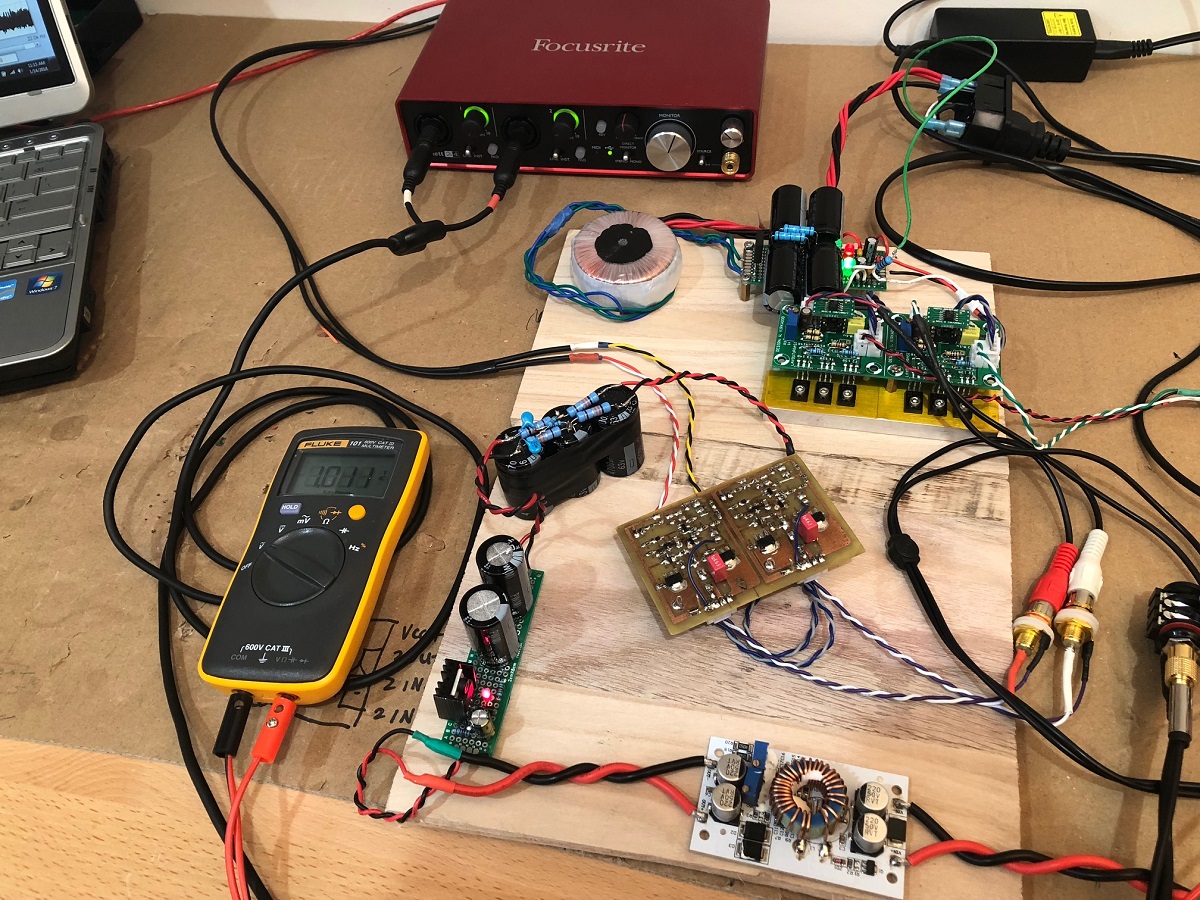
FFT for 1.0vrms into 50ohms, about 0.002% THD but not the most beautiful harmonic profile:
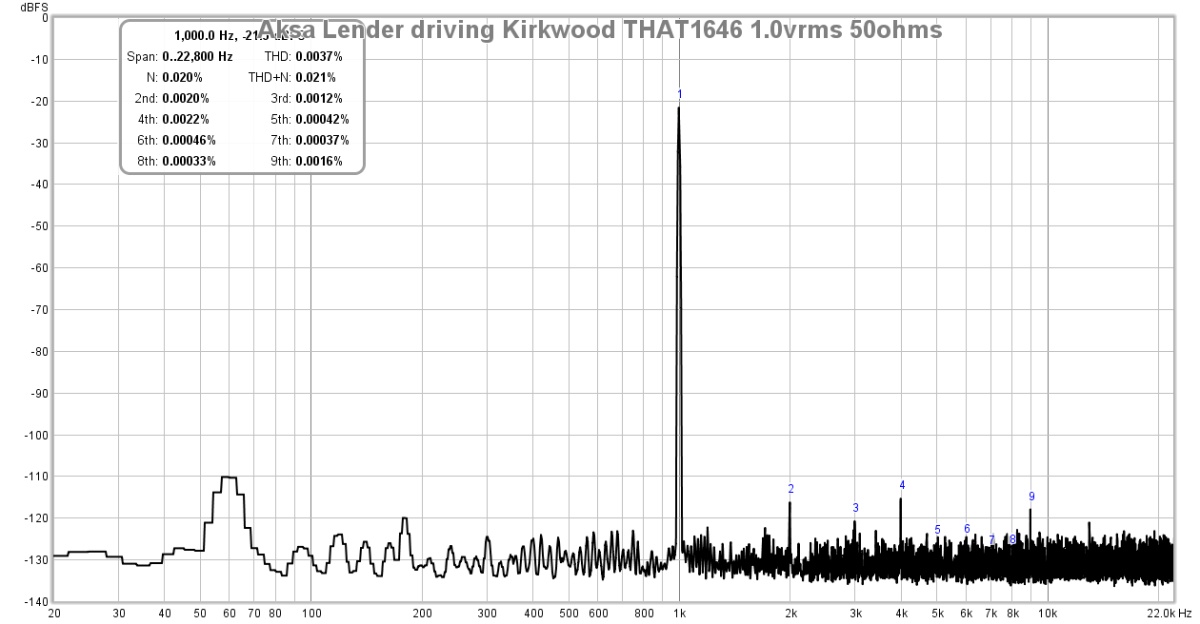
Same FFT but for Aksa Lender with 2SA1837 configured as headphone amp running at 80mA bias, slightly higher overall THD of 0.0056% but much cleaner and more appealing harmonic profile:
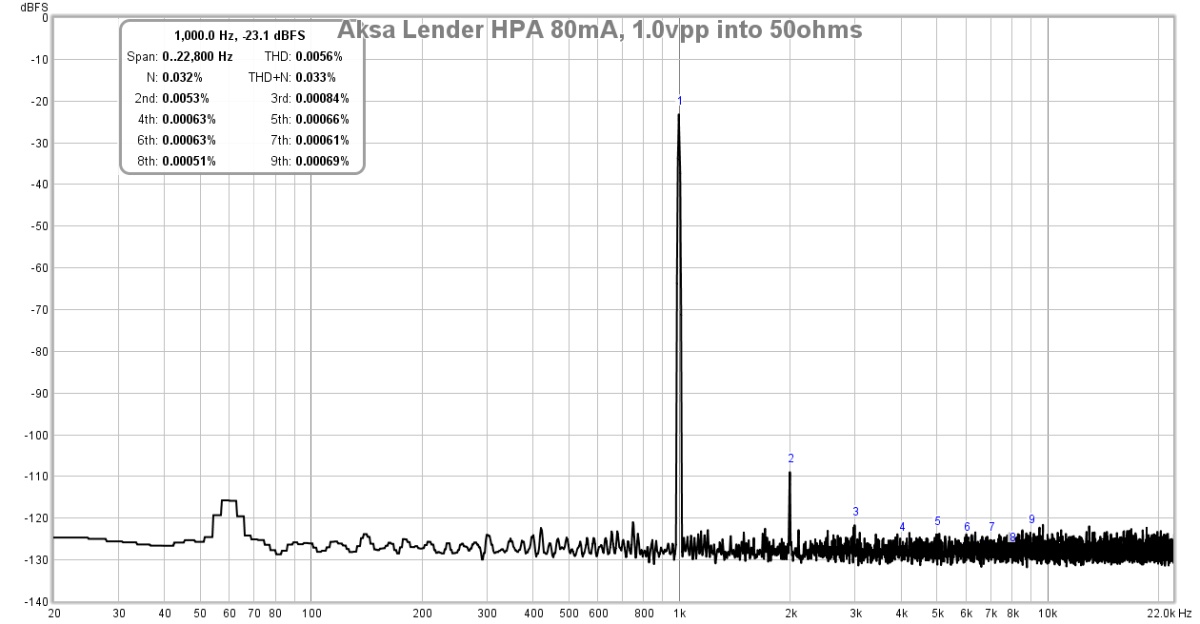
Setup, HPA uses basic toroidal trafo (10VA) and makes dual rail 15v with 7815/7915 regs - hence some 60Hz mains peaks:
FFT for 1.0vrms into 50ohms, about 0.002% THD but not the most beautiful harmonic profile:
Same FFT but for Aksa Lender with 2SA1837 configured as headphone amp running at 80mA bias, slightly higher overall THD of 0.0056% but much cleaner and more appealing harmonic profile:
Attachments
Last edited:
Note that MB has error on R141, should be 10k not 220R.
I found a cheap solution to the X121 connector problem: use standard PCB header mezzanine adapter strips cut to size x 2:
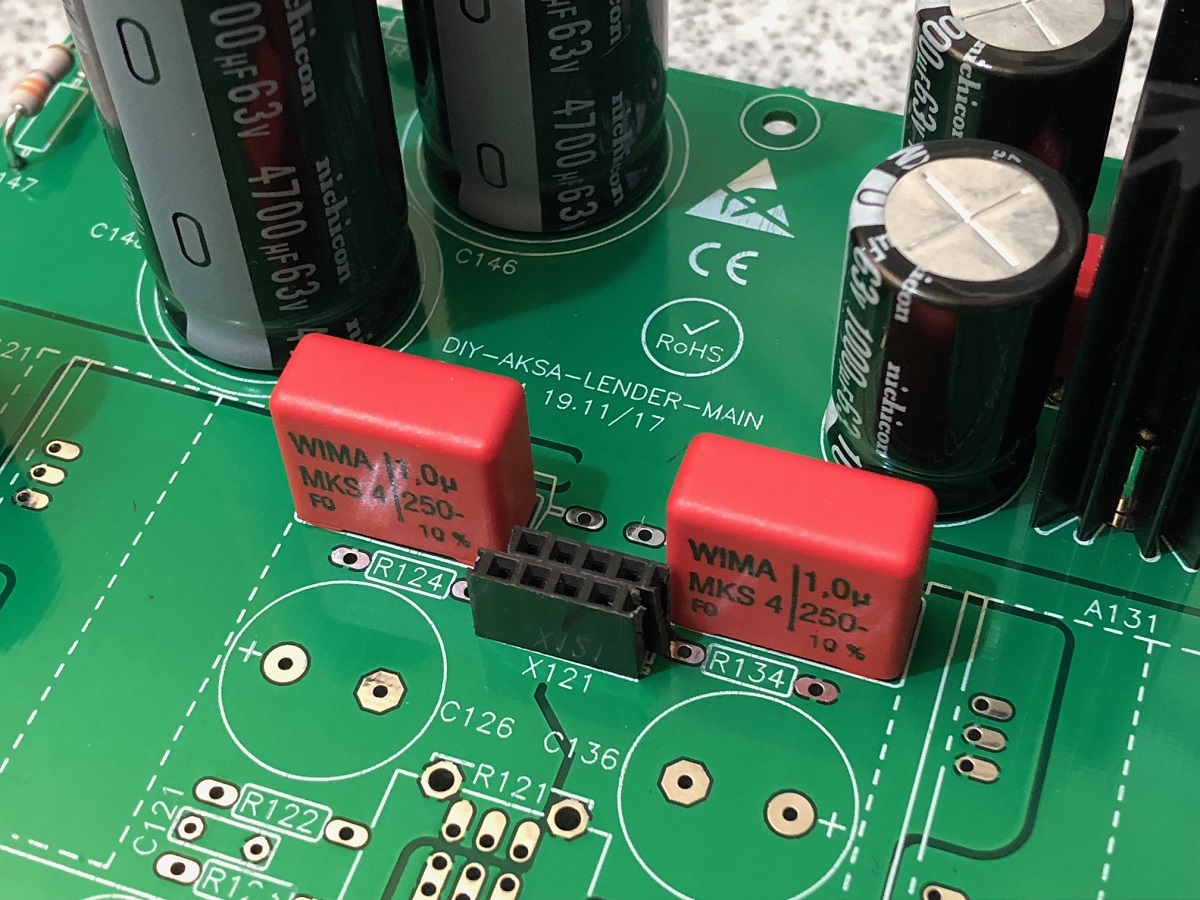
Completed MB #2 configured as a HPA:

I found a cheap solution to the X121 connector problem: use standard PCB header mezzanine adapter strips cut to size x 2:
Completed MB #2 configured as a HPA:
HPA build completed with measurements:
http://www.diyaudio.com/forums/grou...der-preamp-40vpp-ouput-gb-27.html#post5308716
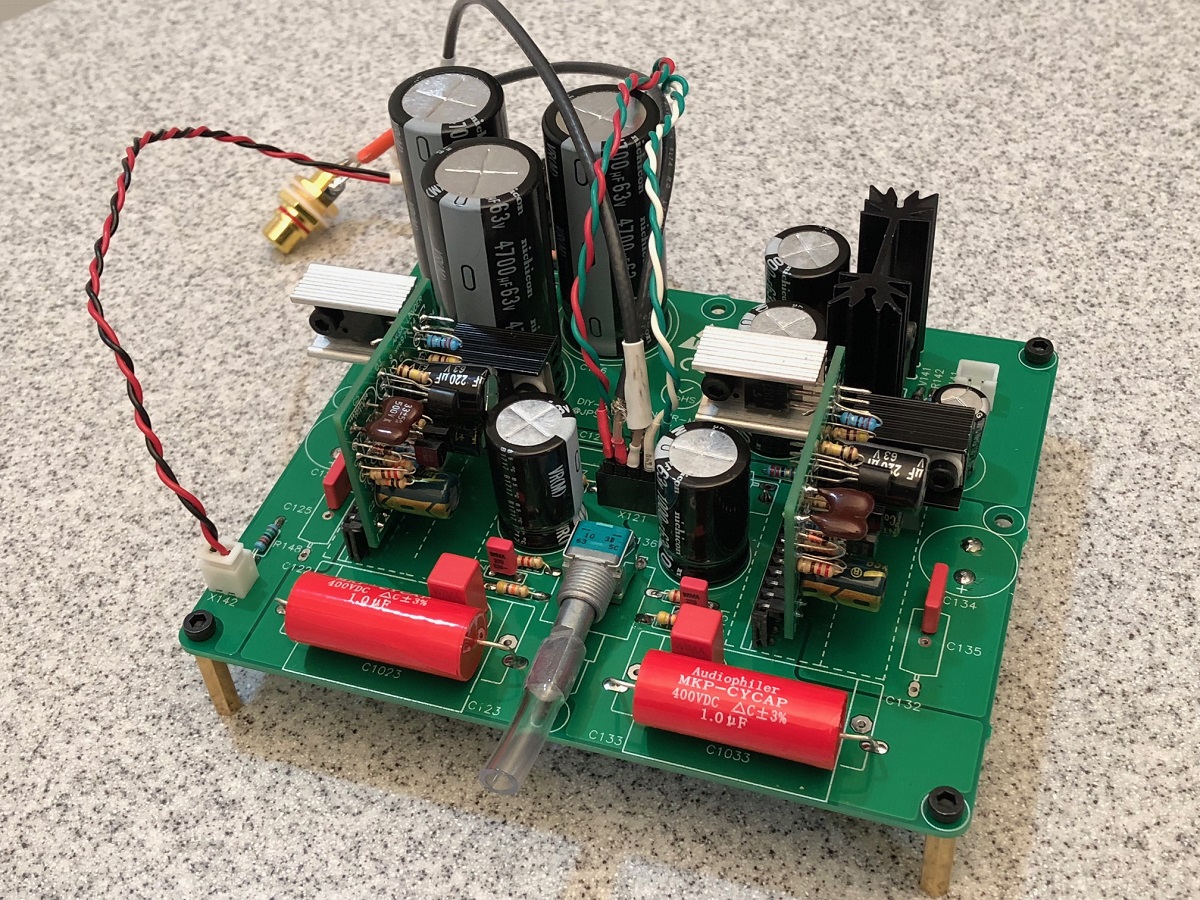
http://www.diyaudio.com/forums/grou...der-preamp-40vpp-ouput-gb-27.html#post5308716
"X" how do you like those Chinese "Audiophiler" caps for coupling applications?
Have you tried any other 1uF MKP caps to see if you could detect any audible differences?
Thanks.
Have you tried any other 1uF MKP caps to see if you could detect any audible differences?
Thanks.
What in the hell is a MKD cap??
Why do you need "back up" caps in the first place?
If you use a quality MKP coupling cap of the correct value, then "back up" caps shouldn't be needed in the first place unless I'm missing something here.
Just another reason while I avoid AC-coupled designs in the first place.
Why do you need "back up" caps in the first place?
If you use a quality MKP coupling cap of the correct value, then "back up" caps shouldn't be needed in the first place unless I'm missing something here.
Just another reason while I avoid AC-coupled designs in the first place.
Last edited:
Just another reason while I avoid AC-coupled designs in the first place.
That's an unfortunate phobia you have because some of the best sounding amps use capacitors in the signal path. Let me ask you what kind of speakers you use on your main non-headphone system? Do they have a passive crossover? Full of caps! 🙂 You can't escape it in the end. Also, professional mastering and studio mixers etc all use balanced line drivers and long cable runs, which almost always are capacitively coupled. So the source we listen to went through many many caps in its creation.
Sorry MKS, I normally use just the 4.7uF Wima MKS but since the board has a big opening for a huge cap, and I had these Chi-Fi polyethylene caps on hand I thought I would try them. They sound quite good - I am comparing side by side to a DC coupled Schiit M3 and of course, the Aksa Lender sounds better even though it is cap-coupled through and through (in and out). Probably noting to do with my super ChiFi input 1uF 400V MKP caps. 🙂 The nice thing with cap coupled amps is that you never have to worry about blowing out your cans if the amp burps DC. The cap multiplier has a soft start ramp up that absolutely is silent with regards to turn on/off pop. None, zilch, no relays or time delay circuits needed.
I just re-adjusted to gain to 16.6dB which is needed for lower sensitivity DT880-250's and it sounds superb now. I dropped bias current down to 110mA. I think that a SE Class A design, always sounds so smooth compared to class AB amps.
With a 260ohm load, the amp is now measuring about 0.0022% THD for 2.0Vpp:
The graph is mislabeled, it is really 2.0Vpp into 50ohms, gets about 0.007% THD:
This is the heart of the amp - the Aksa Lender SE Class A with LTP-Lender input stage on a small daughterboard. Here, in HPA mode, I am using my favorite genuine Toshiba 2SA1837 for the output. Perhaps the best BJT ever made for audio?
Last edited:
Extremely good results, X, better than the Schiit? WOW!!
So you have a AKSA/Lender, only four transistor, to take source to cans?
Cheers,
Hugh
So you have a AKSA/Lender, only four transistor, to take source to cans?
Cheers,
Hugh
Extremely good results, X, better than the Schiit? WOW!!
So you have a AKSA/Lender, only four transistor, to take source to cans?
Cheers,
Hugh
Well, 5 transistors if you count the DN2540 CCS. I was thinking that the M3, being DC coupled, would trounce all over this heavily cap-coupled amp when it comes to dynamics, transparency and soundstage. But the Aksa Lender HPA is quite nice - SE Class A is almost always better sounding than a push-pull Class AB with lots of feedback.
The M3 has very low overall THD, about 0.002% for same 2.0Vpp into 50ohms, but has higher 3rd order than 2nd order, and higher orders 5th, 7th, 9th crop up, albeit very low levels. But I think we can hear these things. The M3 is a fine sounding amp, and a superb value, and if it was all you had, you wouldn't know any better. But, listening to the Aksa Lender HPA side by side, I can really hear a difference. I think I have amassed enough HPA's to have a second round of a virtual HPA blind auditions thread. I have a hybrid tube/SS amp from Massdrop coming next month. That should round-out the comparison...
Here is the M3, measured with same rig at same settings:
Attachments
Last edited:
Hmm...I'd be willing to try one of these Lender preamps if there were a normal sized board available using all TH components as well as suitably sized sinks for the TO-220 devices.
I'm just not into the whole "let's see how small we can make everything" when it comes to PCB layouts, especially when large 100mm boards are dirt cheap.
I'm just not into the whole "let's see how small we can make everything" when it comes to PCB layouts, especially when large 100mm boards are dirt cheap.
I hear what you say, Ammel. BUT, the new world is into small parts in smd, and we need to learn how to work with these parts. I am a bit reluctant too, can't see some of them.
But this pcb is certainly beautifully designed for smd.
HD
But this pcb is certainly beautifully designed for smd.
HD
Hmm...I'd be willing to try one of these Lender preamps if there were a normal sized board available using all TH components as well as suitably sized sinks for the TO-220 devices.
I'm just not into the whole "let's see how small we can make everything" when it comes to PCB layouts, especially when large 100mm boards are dirt cheap.
Look at the photo above - that’s a TH board with suitably sized heatsinks for TO220.
And look at the main board that the daughterboards plug into, all TH. The core amp is small for a good reason, it lets you have a low cost swappable module for flexibility and a tight layout keeps things electrically quieter.
There’s not a single SMT part on this version of the amp. There is an SMT option for the daughterboard, but that’s an option. Most people get the TH version.
Question about the input cap. Is 1uf not enough by itself? I calc about 3.3Hz with 1uf. Seems low enough. Am I missing something?
You are right 3.38Hz is the F3 (for 47k Input load resistor) so if you want flat response to 2 octaves above or about 13.5Hz then that’s enough. But if volume pot is not at max volume, that won’t go as deep. But for all practical music 1uF is fine. I might remove 4.7uF Wima and see if frequency response sweep is affected.
- Home
- Source & Line
- Analog Line Level
- AKSA's Lender Preamp with 40Vpp Output
